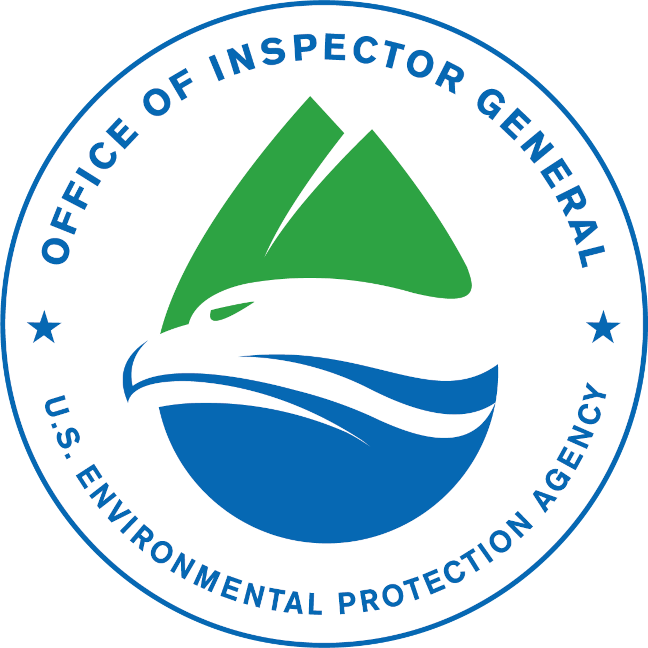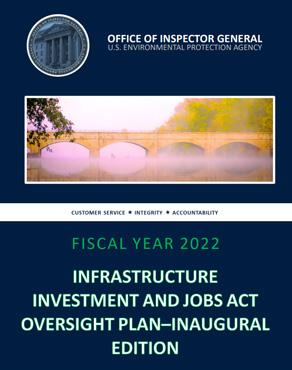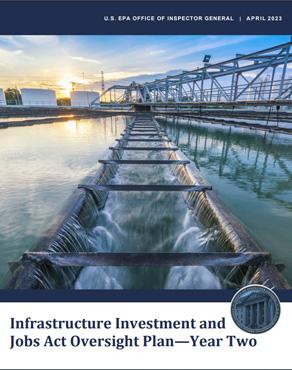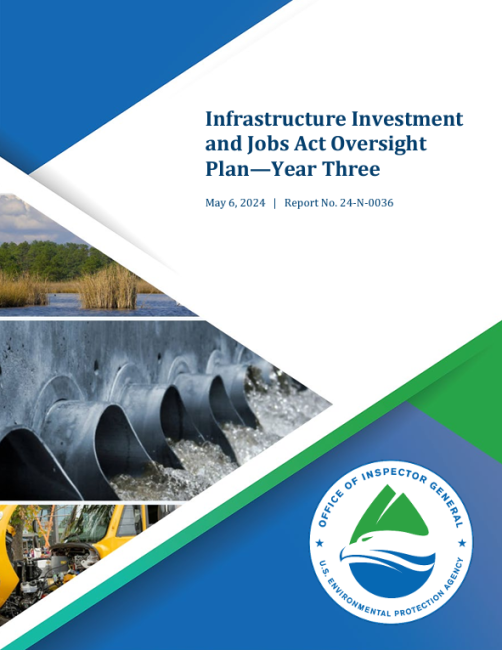
The Infrastructure Investment and Jobs Act appropriates over $60 billion to the U.S. Environmental Protection Agency for a wide range of environmental programs, such as water sector infrastructure, land clean up, and electric school buses. The IIJA also provides for OIG oversight of these funds.
U.S. EPA Infrastructure Investment and Jobs Act (IIJA) Spending Dashboard
The OIG has created the U.S. EPA Infrastructure Investment and Jobs Act (IIJA) Spending Dashboard below to inform the public of current EPA Obligations and Outlays for IIJA projects:
IIJA Oversight Plan
As part of this oversight, we developed an IIJA Oversight Plan, which guides our audits, evaluations, and oversight engagements to address the EPA programs receiving or impacted by IIJA funds. As the Agency refines its plans to execute the IIJA, we will continue to refine and expand our IIJA Oversight Plan.
IIJA Progress Reports
As part of its IIJA oversight role, the OIG will assess whether the EPA is using its roughly $60 billion in IIJA funds in accordance with congressionally designated purposes. OIG oversight will focus on the execution of IIJA funds, the efficiency and effectiveness of the programs receiving IIJA funds, and the detection and prevention of fraud, waste, and abuse. Our annual IIJA progress reports provide updates on our oversight of the EPA’s execution of that funding.
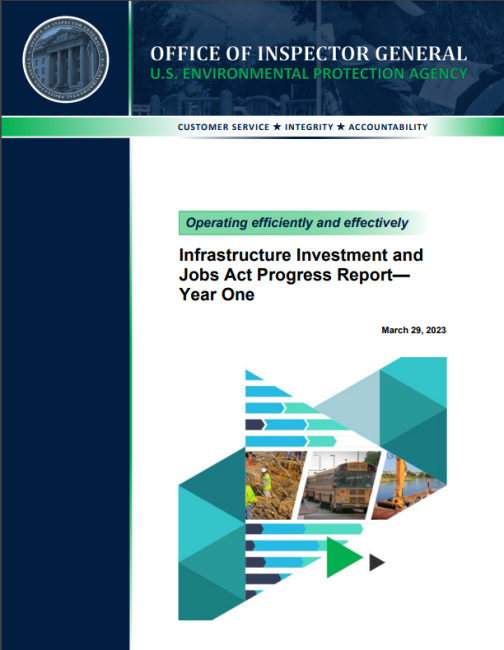
IIJA Progress Report - Year One
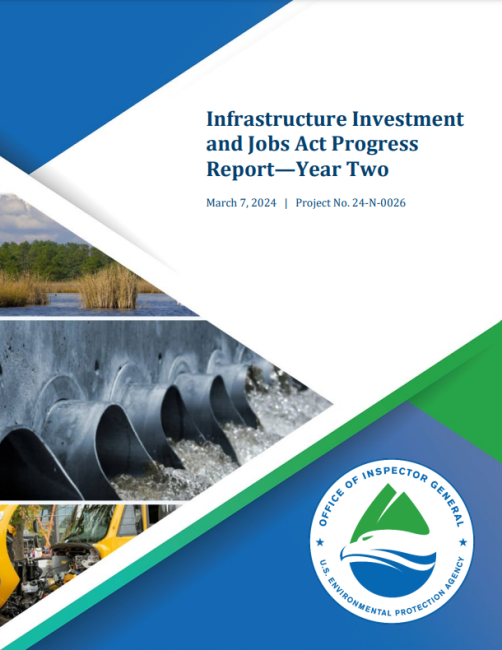
IIJA Progress Report - Year Two
IIJA Progress Report - Year Three
Our groundwork and early oversight also included identifying lessons learned from prior oversight activities; assessing program areas for risk of fraud, waste, or abuse; and initiating several new projects. The OIG has also provided IIJA fraud briefings and conducted several other outreach activities with the Agency, other OIGs with IIJA oversight responsibilities, the U.S. Government Accountability Office, and Congress.
Below is a list of our ongoing and completed IIJA oversight work. As we oversee the EPA’s implementation of the IIJA, we will update this website regularly to provide timely information on our IIJA oversight activities.
Click here to view the Podcast.
Ongoing Infrastructure Oversight Work
The following OIG notification memorandums inform the public about ongoing infrastructure projects:
- The EPA's Infrastructure Investment and Jobs Act funding for the 2022 Clean School Bus Rebate Program, Project No. OA-FY25-0076, July 10, 2025
- Inspection of Infrastructure Investment and Jobs Act-Funded Activities at the Diaz Chemical Corp. Superfund Site in Holley, New York, Project No. OSRE-FY25-0071, June 11, 2025
- Audit of the EPA’s Fiscal Year 2022 Brownfields Assessment Grants, Project No. OA-FY25-0067, May 20, 2025
- Audit of Procurement Fraud Risk Related to Construction Bidding Processes for Clean Water State Revolving Fund Projects, Project No. OA-FY25-0062, April 29, 2025
- Audit of Infrastructure Investment and Jobs Act Funds Awarded to the EPA’s Columbia River Basin Restoration Program, Project No. OA-FY25-0055, April 25, 2025
- Audit of Contractor EnDyna Inc.’s EPA Contracts Containing Inflation Reduction Act (IRA) and Infrastructure and Investment and Jobs Act (IIJA) Funding, Project No. OA-FY25-0032, January 6, 2025
- Audit of Infrastructure Investment and Jobs Act-Funded Indian River Lagoon National Estuary Program Grant Recipient IRL Council, Project No. OA-FY25-0027, October 22, 2024
- Audit of Environmental Finance Centers, funded by annual and Infrastructure Investment and Jobs Act of 2021 Appropriations, Project No. OA-FY25-0015, October 16, 2024
- Audit of EPA Region 1 Awards of the Emerging Contaminants in Small or Disadvantaged Communities Grant Program, Project No. OA-FY24-0126, October 9, 2024
- Evaluation of Institutional Controls at the Cornell Dubilier Electronics, Inc. Superfund Site in South Plainfield, New Jersey, Project No. OSRE-FY24-0125, September 24, 2024
- Evaluation of the U.S. Virgin Islands’ Capacity to Manage and Use Infrastructure Investment and Jobs Act Funds for Clean Water and Drinking Water Infrastructure Improvements, Project No. OSRE-FY24-0118, August 27, 2024
- Evaluation of the Use of Infrastructure Investment and Jobs Act Funds for Drinking Water Security Projects, Project No. OSRE FY24-0105, July 16, 2024
- Audit of the EPA’s Grants Workforce Planning, Project No. OA-FY24-0042, January 29, 2024
- Audit of the EPA’s Post Award Oversight of Grants Awarded Under the Infrastructure Investment and Jobs Act, Project No. OA-FY24-0077, April 18, 2024
- Audit of the EPA’s Resolution of Improper Payments Identified Through Its Annual Review of the State Revolving Fund Program, Project No. OA-FY24-0033, January 16, 2024
- Audit of the States’ and the Commonwealth of Puerto Rico’s Compliance with the Clean Water and Drinking Water State Revolving Fund Annual Financial Statement Audit Requirements, Project No. OA-FY23-0097, September 20, 2023
Completed Infrastructure Oversight Work
The following OIG reports inform the public about completed projects:
-
Evaluation of the EPA’s Implementation of the Underground Injection Control Class VI Well Program
July 28, 2025The EPA met Congress’s intent to spend annual and supplemental appropriations to grow Class VI Program expertise and capacity and improve Class VI permitting with one exception. It did not spend $1.2 million of fiscal year 2023 annual appropriations within the available time frame for their intended purpose: to support training for personnel who regulate Class VI wells. Otherwise, the Agency successfully used annual appropriations to, among other things, increase the number of staff focused on Class VI work, enhance its data and information management tools, and develop additional guidance for Class VI Program implementation.
-
Infrastructure Investment and Jobs Act Oversight Plan—Year Four
June 25, 2025This document provides an update to our plan for oversight of the EPA’s implementation of the IIJA.
The 24 projects summarized in this plan relate to the EPA’s IIJA implementation work, although some of these projects have received or will receive partial support from annual appropriations. The appendix to this IIJA Oversight Plan illustrates which of the EPA’s IIJA programs our 24 projects address.
-
Infrastructure Investment and Jobs Act Progress Report—Year Three
June 25, 2025This report provides updates on the oversight work the OIG planned, initiated, or completed during its third year of IIJA oversight. It also details the OIG’s declaration of 2025 as the “Year of Innovation” and highlights the OIG's continued efforts to engage IIJA stakeholders.
-
Audit of the EPA’s Water Infrastructure Set-Aside Grants to Tribes
June 16, 2025The EPA’s Infrastructure Investment and Jobs Act, or IIJA, funds for the Clean Water Indian Set-Aside, or CWISA, Program and the Drinking Water Infrastructure Grants—Tribal Set-Aside, or DWIG-TSA, Program, collectively referred to as the tribal set-aside programs, were not awarded in a timely manner. About $86.3 million, or roughly 57 percent, of the $152.1 million allocated in fiscal year 2022 IIJA tribal set-aside funds were not awarded to tribes in a timely manner. At the time of our data collection, about $125.3 million, or roughly 76 percent, of the $164.1 million allocated in FY 2023 IIJA tribal set-aside funds had not been awarded to tribes.
-
South Carolina’s Clean Water State Revolving Fund, or CWSRF, program sufficiently meets two of the four dimensions of capacity: financial and organizational. South Carolina faces challenges related to stakeholder and human capital capacity. If South Carolina does not take steps to address those challenges, millions of IIJA dollars intended for water infrastructure improvements may not reach the state’s communities.
-
While the annual review procedures for nondiscrimination laws, suspension and debarment, and single audit requirements follow statutory requirements, we found opportunities for the EPA to improve its oversight practices in the annual review steps devoted to subrecipient monitoring activities in these areas. The EPA provided CWSRF Program guidance that supported the three states that we reviewed in monitoring the subrecipients in their state CWSRF programs. The EPA could further support the states in their subrecipient monitoring activities by providing a guide of best practices for subrecipient monitoring and a best practices guide for helping equivalency subrecipients compliance.
-
Audit Follow-Up: Changes to Grant Information in the EPA’s Grants Management System
May 7, 2025During our audit follow-up, we could not determine a valid reason for the changes. EPA grant staff were also not able to explain why the changes were made. The NGGS does not have adequate controls, such as requiring justifications or approval for changes, to prevent or detect improper changes to grant information. If the EPA cannot rely on the information in the NGGS, its ability to effectively administer and oversee its grants portfolio—which, as of the fall of 2024, totaled 8,713 grants with a value of more than $73 billion—is hampered. Furthermore, inadequate controls within the NGGS increase the EPA’s susceptibility to fraud. Improper changes could also impact the other EPA systems that the NGGS connects with.
-
Evaluation of Institutional Control Documentation in the Superfund Enterprise Management System on IIJA-Funded Sites
March 20, 2025Because of system limitations and insufficient guidance, the information in the classic SEMS “Institutional Controls” module is not complete and available for reporting, monitoring, and other oversight activities. The upgrade to SEMS 2.0 is unlikely to improve this condition. Specifically, classic SEMS and SEMS 2.0 do not track institutional controls as independent elements of a site remedy, and they do not allow users to track planned institutional controls. In addition to these system design limitations, at the time of our fieldwork, the Office of Land and Emergency Management had not mandated that the regions use the “Institutional Controls” module, nor had it issued guidance regarding the purpose and use of the module. Consequently, the regions do not use the “Institutional Controls” module consistently, so the data do not completely or accurately reflect actual site conditions.
-
Evaluation of the EPA Office of Water’s Guidance to State Revolving Fund Programs for Implementing the Build America, Buy America Act Requirements
February 19, 2025While the EPA Office of Water issued two memorandums on implementing the Build America, Buy America Act requirements, its guidance related to manufactured products, documenting compliance, the consequences for noncompliance, using current waivers, and applying for new waivers was not sufficient.
-
EPA guidance generally addresses IIJA Drinking Water State Revolving Fund emerging contaminants provisions. These provisions include focusing on projects that address per- and polyfluoroalkyl substances, or PFAS. However, the EPA’s guidance does not detail allowable ranking and funding levels of non-PFAS projects. Further, the EPA guidance does not adequately describe how to process transfers between different state revolving funds.
-
The EPA Left $20 Million Unawarded in the Sewer Overflow and Stormwater Reuse Municipal Grants Program
February 10, 2025The EPA did not consistently manage its Sewer Overflow and Stormwater Reuse Municipal Grants Program in accordance with some applicable laws, regulations, policies, and guidance. As of January 10, 2024, the EPA had not awarded approximately $20 million, or about 18 percent, of the approximately $110 million allocated to states within the program for fiscal years 2020 through 2022. In addition, the EPA failed to meet its statutory requirement to submit a report to Congress and allowed a cost share to be imposed on a grant that should have been exempt because the communities to benefit were rural or financially distressed.
-
The EPA Should Improve Monitoring of 2022 Clean School Bus Rebate Recipients’ Use of Funds and Deployment of Buses and Infrastructure
December 4, 2024The EPA did not monitor bus deployment status and recipient use of over $836 million of 2022 Clean School Bus, or CSB, Program rebates, despite the Agency stating it would do so in the 2022 Clean School Bus (CSB) Rebates Program Guide. As of June 2024, only 22, or 6.1 percent, of the 360 schools that received rebates in 2022 had completed their rebate closeouts. At the time of this audit, ten of the 17 schools we reviewed, or 59 percent, are in the process of installing the infrastructure necessary to operate the new clean buses and may not meet the program closeout deadline of October 2024.
-
Management Implication Report: Poor Data Management Hinders Oversight of State Clean and Drinking Water State Revolving Fund Programs
October 28, 2024Some states are collecting and storing their CWSRF and DWSRF subrecipient and contractor data in unstructured or nonmachine-readable formats. Data that are not collected or stored in a structured database or machine-readable format can be difficult to access and can significantly inhibit the ability to use data analytics for proactive oversight of the state revolving funds.
-
The EPA’s 7th Drinking Water Infrastructure Needs Survey and Assessment did not result in allotments of lead service line, or LSL, funds that accurately reflected the LSL replacement needs in each state. The LSL questionnaire lacked the rigorous internal controls needed to ensure data quality and reliability, and the EPA did not implement the needed internal controls.
-
Most States Did Not Provide Some Required Fee Information in the Intended Use Plan or Annual Report for Their Clean Water State Revolving Funds
September 30, 2024Most of the 47 states that charged fees to Clean Water State Revolving Fund loan recipients did not provide some required fee information in either their intended use plan or annual report for 2022. The EPA Office of Water’s guidance was not clear with respect to the definitions of the required information and how regional reviewers should obtain missing information.
-
Audit of the Brownfields Program Implementation of Justice40 Initiative Goals and Related Requirements for Infrastructure Investment and Jobs Act-Funded Projects
September 24, 2024The EPA’s Brownfields Projects Program met the Executive Office of the President’s Justice40 Initiative reporting requirements for fiscal year 2022 IIJA-funded projects. The program is also projected to meet the EPA’s internal goal of ensuring that at least 40 percent of program benefits go to disadvantaged communities. However, the Agency overestimated the percentage of benefits going to disadvantaged communities for fiscal year 2022.
-
Management Implication Report: Some States Failed to Conduct Required Financial Audits of Their State Revolving Funds
September 12, 2024The statutes creating the SRFs require states to conduct financial and compliance audits of their SRFs. The EPA’s implementing regulations require, among other things, that the states send these audits to the OIG and that the OIG review the audits. Until our April 2023 request, the states have not submitted their audits to the OIG so that the OIG can determine whether those audits meet regulatory requirements.
-
The EPA Needs to Improve Internal Controls for Selecting Recipients of Clean School Bus Program Funds
July 31, 2024While the EPA followed six of the seven requirements to select recipients of Clean School Bus Program funds, sufficient internal controls were not in place to ensure that it selected recipients with eligible school buses. Additionally, the EPA did not provide oversight to verify that applicants requesting funds specifically for zero-emission school buses have school districts with suitable local conditions for these types of buses.
-
The EPA Should Improve Oversight of Physical Access and Institutional Controls at the Escambia Wood Superfund Site
June 12, 2024The EPA is not providing sufficient oversight of the maintenance of engineering controls, specifically physical access controls, and institutional controls to protect human health and the remedy addressing soil contamination at the site. Camping and trespassing have been ongoing issues since at least March 2007. However, the EPA did not work with state and local partners to enforce the established institutional controls or take administrative action to ensure this unauthorized use did not continue even though the protectiveness of the remedy depends on it.
-
New Mexico’s Capacity to Effectively Manage Clean Water Infrastructure Funds Faces Challenges
June 5, 2024The New Mexico Environment Department, or NMED, is sufficiently meeting the financial and organizational dimensions of capacity to manage and use its infrastructure funds for the Clean Water State Revolving Fund, or CWSRF, Program. However, the NMED faces stakeholder- and human-capital-related challenges that limit its capacity to effectively manage and use its CWSRF Infrastructure Investment and Jobs Act, or IIJA, funding. These challenges are compounded by the fact that the NMED is not fully staffed and has difficulty filling its vacancies.
-
As we evaluated the execution of the EPA’s 7th Drinking Water Infrastructure Needs Survey and Assessment, or DWINSA, we saw indications that a lack of internal controls may have caused the EPA to base its fiscal year 2023 allotment of $3 billion in IIJA funds for lead service line replacements on inaccurate data. As such, there is a risk that the EPA did not allot the fiscal year 2023 IIJA funds, and will not allot future IIJA funds, according to states’ lead-service-line-replacement needs.
-
As of December 2023, the EPA had issued 11 Build America, Buy America Act waivers. The EPA did not track the use of ten of these waivers across EPA-funded infrastructure projects. The Agency was unable to provide the number of award recipients that fall under the waivers and does not have a method in place to track this information.
-
Infrastructure Investment and Jobs Act Oversight Plan—Year Three
May 6, 2024The OIG described its planned and ongoing audits, evaluations, and other engagements related to the EPA’s implementation of the IIJA for fiscal year 2024, or Year 3, and beyond.
-
The institutional controls that the EPA has established at the American Creosote Works Inc. Superfund site in Pensacola, Florida, related to contaminated groundwater and soil are not sufficient to prevent potential exposure to contamination, potentially wasting over $6 million in IIJA funds. The EPA is also missing opportunities to communicate the risks associated with off-facility impacted parcels to the public using the public-facing site profile webpage.
-
The EPA prioritized climate adaptation and provided guidance to states during the development of their annual clean water state revolving fund intended use plans, or CWSRF IUPs. Despite these actions, only 25 states included climate adaptation or related resilience efforts in their 2022 IUPs. In addition, only 13 states included climate adaptation or related resilience efforts as part of the project prioritization criteria documented in their 2022 IUPs. In fiscal year 2022, the EPA awarded $1.2 billion out of the available $3 billion CWSRF funds—which included annual and IIJA appropriations—to states that did not include resilience in their IUPs.
-
The EPA’s Office of Water has not always ensured that EPA regional offices adhered to the Clean Water State Revolving Fund, or CWSRF, annual review guidance, nor does the office consistently monitor annual reviews. This guidance on CWSRF audit requirements is inconsistent with program regulations, which implement Clean Water Act audit requirements. Without proper oversight of the annual review process CWSRF funds will be more susceptible to fraud, waste, and abuse.
-
Infrastructure Investment and Jobs Act Progress Report—Year Two
March 7, 2024The OIG provided an annual update on its oversight of EPA’s implementation of the IIJA, which appropriates over $60 billion to the EPA for fiscal years 2022 through 2026, representing the largest appropriation that the Agency has ever received. This second annual IIJA progress report provides updates on the OIG’s oversight of the EPA’s execution of that funding through January 31, 2024.
-
Perspectives on Capacity: Managing Drinking Water State Revolving Fund Infrastructure Investment and Jobs Act Funding
February 27, 2024In response to an OIG survey, most state Drinking Water State Revolving Fund, or DWSRF, administrators agreed their agencies had the organizational capacity necessary to manage IIJA DWSRF funds. However, a few state DWSRF administrators expressed concerns. State DWSRF administrators reported workforce management and insufficient federal guidance as common obstacles limiting their agencies’ capacity to manage DWSRF IIJA funds. They specifically noted insufficient guidance related to the Build America, Buy America Act provisions of the IIJA. In addition, a few state DWSRF administrators cited a lack of coordination with the EPA as an obstacle.
-
The EPA Needs to Improve the Completeness and Accuracy of the Obligation and Outlay Information That It Reports in USAspending.gov
January 9, 2024The EPA’s initial reporting of its fiscal year 2022 spending in USAspending.gov was not complete or accurate. Additionally, the Office of the Chief Financial Officer lacked procedures to detect errors and to confirm the completeness and accuracy of the data that it reported to USAspending.gov. Reporting in USAspending.gov is critical, as it is the primary way the EPA informs the public of the purpose of its federal awards and where its funding ultimately goes.
-
The EPA Clean School Bus Program Could Be Impacted by Utility Delays
December 27, 2023The EPA may be unable to effectively manage and achieve the program mission unless local utility companies can meet increasing power supply demands for electric school buses. The EPA provided utility resources during the rebate application process but did not require applicants to contact their utility provider to coordinate potential changes needed to connect charging stations to utilities.
-
Management Implication Report: Preventing Fraud, Waste, and Abuse Within the EPA’s Clean School Bus Program
December 27, 2023The EPA lacked robust verification mechanisms within the Clean School Bus Program rebate and grant application process, which led to third parties submitting applications on behalf of unwitting school districts, applicants not being forthright or transparent, entities self-certifying applications without having corroborating supporting documentation, and entities being awarded funds and violating program requirements.
-
Status of Unliquidated Obligations for Programs Receiving Funding from the Infrastructure Investment and Jobs Act
September 28, 2023The EPA had over $1.55 billion in unliquidated obligations with inactivity of 180 days or more for fiscal years 2018 through 2023. This includes approximately $429 million in IIJA appropriations in fiscal years 2022 and 2023. The large amount of funds received through the IIJA provides an additional challenge for the Agency. Rather than sitting idle, awarded funds could be put to better use by communities that are ready to proceed with environmental projects.
-
Infrastructure Investment and Jobs Act Oversight Plan—Year Two
April 27, 2023The OIG described its planned and ongoing audits, evaluations, and other engagements related to the EPA’s implementation of the IIJA for fiscal year 2023, or Year 2, and beyond.
-
Infrastructure Investment and Jobs Act Progress Report—Year One
March 29, 2023The OIG provided the first annual update on its oversight of EPA’s implementation of the IIJA, which appropriates over $60 billion to the EPA for fiscal years 2022 through 2026, representing the largest appropriation that the Agency has ever received.
-
Compendium of Open and Unresolved Recommendations Related to Infrastructure Investment and Jobs Act-Funded Programs
March 23, 2023The OIG analyzed open and unresolved recommendations related to EPA programs that received funding under the IIJA.
-
American Recovery and Reinvestment Act Findings for Consideration in the Implementation of the Infrastructure Investment and Jobs Act
December 7, 2022The OIG reviewed prior oversight work related to EPA programs that received funds under the American Recovery and Reinvestment Act and identified lessons learned that could help the EPA prepare, implement, and oversee programs receiving IIJA appropriations.
-
Considerations from Single Audit Reports for the EPA’s Administration of IIJA
September 15, 2022The OIG reviewed prior single audit reports and highlighted relevant findings to help the EPA prepare to administer an additional $60 billion in funds pursuant to the IIJA. We identified seven areas where noncompliance with applicable federal laws, regulations, and program requirements were most frequent.
-
Considerations for the EPA’s Implementation of Grants Awarded Pursuant to the Infrastructure Investment and Jobs Act
August 11, 2022The OIG reviewed prior oversight reports to identify lessons learned that are relevant to the EPA’s administration and oversight of grant awards pursuant to the IIJA. With IIJA appropriations, the EPA will receive approximately $55 billion in additional funding for grants over a five-year period.
-
Lessons Identified from Prior Oversight of the EPA’s Geographic and National Estuary Programs
August 8, 2022The OIG reviewed prior oversight reports and identified seven programmatic themes or lessons learned from prior oversight reports that could help the EPA administer the $1.85 billion of IIJA funding appropriated for the Agency’s 12 geographic programs and National Estuary Program.

